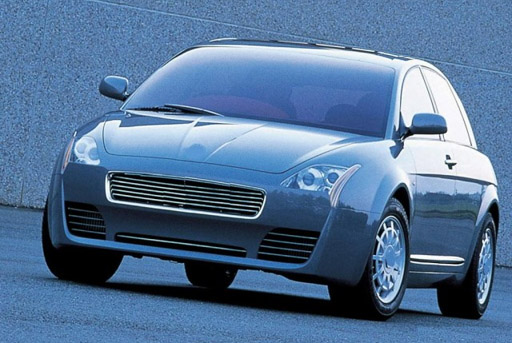 It was designed in the Italian workshops Italdesign, a functional prototype was created in the American department of the studio, in California. This is not a coincidence, because Buran is to create a vision of a vehicle that meets the requirements of a wealthy clientele of both continents. It should therefore offer the same comfort when driving fast on German highways, as well as steadily overcoming many miles on US roads, in line with those there, stringent speed limits. At the same time, Giugiaro remained faithful to the idea of creating a car "from the inside", consisting in enclosing a spacious body with a silhouette (wheelbase 2930 mm) easily accessible interiors. Two-and-a-half-box shape, with a barely accentuated outline of the trunk, creates an impression of security and reliability. From the outside, they are reinforced with glazed surfaces, small in relation to the sheet metal surfaces. The massive front segment is covered with a V-shaped one, eight-cylinder power unit, borrowed from Maserati 3200 GT, located longitudinally and transmitting the drive constantly to all wheels. With four valves per cylinder and turbo boost, it develops power 271 kW and torque 491 Nm. The passenger compartment is equipped with electric rear doors. Hull structure with high structural rigidity (with wide C-pillar) allowed for the abandonment of the center post, therefore getting in and out is easy, also in tight parking lots.
It was designed in the Italian workshops Italdesign, a functional prototype was created in the American department of the studio, in California. This is not a coincidence, because Buran is to create a vision of a vehicle that meets the requirements of a wealthy clientele of both continents. It should therefore offer the same comfort when driving fast on German highways, as well as steadily overcoming many miles on US roads, in line with those there, stringent speed limits. At the same time, Giugiaro remained faithful to the idea of creating a car "from the inside", consisting in enclosing a spacious body with a silhouette (wheelbase 2930 mm) easily accessible interiors. Two-and-a-half-box shape, with a barely accentuated outline of the trunk, creates an impression of security and reliability. From the outside, they are reinforced with glazed surfaces, small in relation to the sheet metal surfaces. The massive front segment is covered with a V-shaped one, eight-cylinder power unit, borrowed from Maserati 3200 GT, located longitudinally and transmitting the drive constantly to all wheels. With four valves per cylinder and turbo boost, it develops power 271 kW and torque 491 Nm. The passenger compartment is equipped with electric rear doors. Hull structure with high structural rigidity (with wide C-pillar) allowed for the abandonment of the center post, therefore getting in and out is easy, also in tight parking lots.
The front door is traditionally hung, on the A pillars. Flat cabin floor, with seats on rails, allows for free arrangement of space: folding backrests transform individual armchairs into tables, np. for the computer, and the full-range adjustment of the seat and backrest position facilitates the selection of the appropriate setting. On the one hand, the high position of the people on the move ensures good visibility, on the other hand, it is correct, anatomical position. The central console is movable and can be used not only by the driver and his companion, but also three rear passengers. As befits a luxury car, trim elements are made of noble, varnished wood, and leather upholstery. The tachometer and clock are at the forefront of the instrument cluster, which are constantly visible, other instruments remain hidden, revealing itself when necessary.
The instrument panel flows smoothly into the plane of the door. The central module groups the devices controlling the satellite navigation system and the radio, air conditioning, etc.. You can contemplate the surrounding landscape through the glass panels in the roof. The seemingly rudimentary rear segment hides not very large, but a sufficient trunk with a sliding lid upwards, which protects passengers against wind and cold when it is opened.
Maserati Buran
